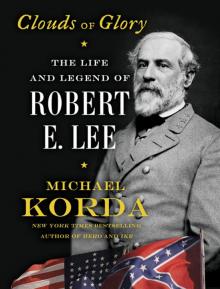- Home
- Michael Korda
Clouds of Glory Page 51
Clouds of Glory Read online
Page 51
In the meantime, Jackson was marching his army north to meet the enemy—it was not so much a well-thought-out plan on either side as a collision. Jackson’s 24,000 men were marching in brutal, pitiless heat and dust. As usual he had not shared his intentions with any of his senior officers, nor did he have any fancy maneuvering in mind this time. Word had reached him that Pope had ordered General Banks to advance south toward Gordonsville, and Jackson planned to meet him on the way and fight him when he encountered him, and that was that.
Pope, who seems to have misjudged Jackson’s character, assumed that he was retreating. In fact, Jackson was moving as fast as he could, hoping to overwhelm a portion of Pope’s army while it was isolated and exposed. Despite his secretive and sometimes difficult character, Jackson had one great advantage—when he wanted, he could read Lee’s mind. Just over fifty years later, when General Joffre was asked how he proposed to defeat the larger and rapidly advancing German army at the Marne in 1914, he replied, “Je les grignote.” (“I am nibbling away at them.”) In this way Joffre succeeded in stopping the Germans virtually at the gates of Paris by inflicting on them a constant rate of loss they could not support, and depriving them of the opportunity to concentrate their forces. This was Lee’s idea too: that Jackson should attack isolated parts of Pope’s army with superior numbers, rather than risk a single decisive battle.
This time Jackson once again had the services of his cartographer Captain Hotchkiss, who managed to find routes for the march along obscure, unnamed country roads. Under a blazing sun—the temperature during the day never dropped below ninety degrees—and amid clouds of choking dust Jackson’s troops managed to cover only eight miles on the first day. Neither the soldiers nor their senior commanders had any idea where they were going except toward the next low, rolling hill in front of them.
They reached Orange Court House by nightfall, and at “earliest dawn” resumed their march, on a day that would reach ninety-six degrees. During the night Jackson had changed his mind about the order of march, sending Ewell, whose division had been in the lead, to a different route via Liberty Mills without informing A. P. Hill. The resulting confusion (and vivid resentment on A. P. Hill’s part) and the intense heat caused a lot of straggling, and immense suffering for the animals, and slowed the progress of the army to a crawl. Worse still, while a seething Hill struggled to make sense of his orders, Jackson’s old division, meant to be the last in line, got ahead of him, with the result that “nightfall found the Confederate army spread out over parts of three counties,” only fifteen miles from Culpeper, but hopelessly unconcentrated. From the standpoint of military orthodoxy, it made sense to advance the army by parallel routes, rather than trying to cram them along one narrow road—but by neglecting to inform A. P. Hill of his decision Jackson almost ensured that his three divisions would all meet the enemy at different times and places, with no way of communicating with each other. By now the element of surprise had been lost. Banks knew perfectly well that Jackson was advancing toward him, and was preparing to meet him on a line almost a mile and a half long drawn perpendicularly across the main road just a mile and a half northwest of Cedar Mountain, the most prominent feature of the landscape ahead of Jackson. Cedar Mountain (also called, less promisingly, Slaughter’s Mountain by the locals, after the family who lived closest to it) was not really a mountain, but a broad, kidney-shaped wooded hill, less than 300 feet high. It was girdled to the north by a fordable stream, the south fork of Cedar Run, and overlooked the main road to Culpeper. Hotchkiss’s map of the area is wonderfully clear, but it was made a year after the battle, allowing for twenty-twenty hindsight. At the time, it was much less clear to Jackson what the countryside ahead of him looked like, and the one man who could tell him was A. P. Hill, a Culpeper boy, with whom Jackson had already had harsh words that day, and whose advice Jackson was unlikely to seek.
The Reverend Major Dabney, Stonewall Jackson’s faithful former chief of staff, describes the area between Orange and Culpeper as “a region of pleasant farms, of hills and dales, and of forests interspersed,” which is no doubt accurate enough, but fails to mention the phenomenal heat. On August 9 Jackson had his army moving north toward Culpeper well before dawn on a day “that must have been one hundred degrees in the shade,” according to one soldier. Around eleven o’clock in the morning Federal cavalry were seen on a long, low ridge to the west of Cedar Mountain, shimmering in the heat haze, and signaling the presence nearby of General Banks’s corps. Jackson saw at once the importance of getting some of his artillery onto higher ground on the northern slope of Cedar Mountain, which turned out to be steeper and more difficult to approach than it had looked from a distance, but by 1:00 p.m. his gunners had succeeded, and a fierce artillery duel was under way. Confederate troops began to form a rough-and-ready crescent-shaped line to the left of Cedar Mountain, on the open ground of a cornfield and an adjoining a field of stubble, although Hill’s division was still miles away thanks to Jackson’s decision to change the order of march.
At this moment Jackson paused to play with some children in the yard of a nearby farmhouse and then stretch out on its porch for a nap. Even his admiring biographer James I. Robertson Jr. finds this odd, but the truth is that Jackson seems to have shared Napoleon’s gift for taking a catnap in the middle of a battle. Mrs. Petty’s modest farmhouse was a mile away from the traffic jam of wagons and artillery that was holding up the arrival of Hill’s division, and less than two miles from where those of his infantry brigades which had arrived on the field were deploying, and until something happened Jackson was as well off dozing on her porch as elsewhere.
By early afternoon the artillery duel had become one of the most intense of the war so far, audible as far away as Richmond, according to some; and Jackson rode to the center of it to watch calmly, binoculars in hand, one leg out of the stirrup and thrown across the pommel of his saddle as if he were sitting in a chair, until a Federal infantry charge threatened to engulf him. As with most great commanders, Jackson’s calm in the middle of chaos and carnage set a stern example for his troops. After an afternoon of hard fighting and constant shelling, it seemed only too likely that by six o’clock Jackson’s left would be overwhelmed, and his forces driven from the field. Jackson knew that there was a moment in battle when calmness will no longer suffice—he put his spurs to Little Sorrel and galloped straight to the left, where the fighting was fiercest and the Confederate line was collapsing, the fields and woodland “filled with clamor and horrid rout,” as Dabney puts it. He reached for his saber to rally the men, only to find he had drawn it so seldom that it was rusted firmly into the scabbard. Undeterred, Jackson unfastened sword and scabbard from his belt, and brandishing both over his head with one hand, he grabbed a Confederate battle flag with the other and charged into the thick of the fight shouting at his troops to follow him, “in a voice which pealed higher than the roar of battle. ‘Rally, brave men, and press forward! Your general will lead you. Jackson will lead you. Follow me!’” These may not have been his exact words—Dabney was not present at the battle and was writing a year after Jackson’s death—but whatever Jackson shouted, the sight of him capless (his stained old VMI cap had caught on a low branch) and looking like an Old Testament prophet, “his face flaming with the inspiration of battle,” charging directly toward the Federal line, was enough to make his troops follow him at a run. They deployed quickly behind a fence and fired a volley at point-blank range into the oncoming Federal ranks with withering effect.
Even Jackson’s flamboyant charge might not have saved the day, if it had not coincided with A. P. Hill’s arrival with his division. From that point on until darkness the battle continued, but Jackson by now had all his troops on the field—“his blood was up; and he delivered blow after blow from his insulted left wing, with stunning rapidity and regulated fury”—while Hill’s division advanced on the right, close to Cedar Mountain, to turn the Federal left.
The fighting went on into the night u
ntil eleven o’clock. Jackson was determined to reach Culpeper, seize Pope’s supplies, and interrupt his major line of communication, the Orange and Alexandria Railroad. But the troops were too exhausted to continue the pursuit, and information from prisoners and Jackson’s own cavalry soon made it evident that Major General Franz Siegel’s Union corps was close behind Banks. With two Federal corps uniting in front of him Jackson’s opportunity for isolating and destroying them one by one was gone. He halted his army along a line just a mile or two north of the battlefield. Impulsive as Jackson could be, he was a thoroughly professional soldier, willing to fight when the odds were against him, but realistic when they appeared overwhelming. He consolidated his line and on August 11, two days after the battle, agreed to a truce to allow the Federals to bury their dead. Jackson took advantage of the lull to start moving the bulk of his army back in an orderly fashion toward Gordonsville. Employing an old ruse, he lit campfires in the dark “as if the troops were preparing their evening meal.” Jackson had inflicted 2,353 casualties on Banks, for a total of 1,338 himself,* a victory if one counted the numbers, but not the victory he had wanted.
All the same, it was a vital turning point. From Washington, Halleck urged caution on Pope—who one would have thought was exceeded in that respect only by McClellan. Pope’s full attention remained fixed on Jackson. Perhaps even more important, Jackson’s victory at Cedar Mountain raised southerners’ spirits, and undermined Pope’s fragile self-confidence. Like McClellan, he thought himself outnumbered and clamored for reinforcements. Burnside was dispatched to join Pope, and the process of moving McClellan’s army from Harrison’s Landing to northern Virginia was accelerated. No one in Washington looked toward the Blue Ridge Mountains, where Lee quietly began to move Longstreet’s forces to join with Jackson. He was determined to concentrate the Army of Northern Virginia before McClellan arrived to join his army to Pope’s.
On August 15, the most significant military movement of all took place. Robert E. Lee arrived by train in Gordonsville to confer with Jackson, Longstreet, and Stuart, and to take personal command of the army.
The flurry of orders Lee sent from Richmond between hearing of Jackson’s victory at Cedar Mountain on August 10 and departing with his staff for Gordonsville demonstrates his single-minded grasp of the strategic situation, and his determination to move with all possible speed, before the addition of McClellan’s army to Pope’s made the Federal forces outside Washington too numerous for him to be able to defeat. His “window of opportunity” was narrow, and he knew it.
We do not know if Lee left Richmond with relief at returning “to the field.” He and his staff had been quartered at the Dabbs house on Nine Mile Road again since the Battle of Malvern Hill, far enough from the center of Richmond to be spared the epidemic of illness that the heat and the large number of wounded inevitably produced. Malaria, typhoid fever, and dysentery were rampant, and almost every house and public building had its quota of sick and wounded. In her book about the Lee daughters, The Lee Girls, Mary Coulling quotes a vivid description of Richmond as “one immense hospital’ where citizens ‘breathed the vapors of the charnel house,” which was surely no exaggeration. The “Seven Days” battles had produced nearly 16,000 Confederate wounded alone. Ignoring her husband’s sensible advice as usual, Mary Lee had returned from the North Carolina spa where her little grandson Rob had died of pneumonia. Both Mrs. Lee and her daughter Mary, like most of the ladies of Richmond, devoted themselves to nursing, which in the days before antiseptics and modern plumbing was almost as dangerous as the battlefield. In addition to looking after Rooney’s grief-stricken wife, Charlotte, who had lost both her infant son and her home, which had been burned to the ground by Union troops, Mary looked after her oldest son, Custis, who lay dangerously ill in Richmond. For a man whose chief joy lay in his family, Lee found himself in 1862 without a home to call his own, and with most of his children scattered and many of them exposed to danger. Custis was serving as an aide-de-camp to President Jefferson Davis; Rooney was a colonel, who would soon be promoted to command his own brigade of cavalry under J. E. B. Stuart; young Rob was serving as a gunner in Stonewall Jackson’s army; Annie, Agnes, and Mildred remained for the moment in North Carolina. “He was the same loving father to us all, as kind and thoughtful of my mother, who was an invalid, and of us, his children, as if our comfort and happiness were all he had to care for,” Rob notes, adding that his father’s victories “did not elate him”—hardly surprisingly, since Lee still reproached himself for not destroying McClellan’s army at Malvern Hill.
Mrs. Lee cannot have been cheered by a letter her cousin Markie Williams managed to send “through the lines” about another “sad” visit Markie had paid to Arlington. She told Mrs. Lee that the wife of the Union general occupying the mansion was using her room downstairs as the parlor, and enclosed a pressed leaf from the garden, cut for Mary by one of her own slaves. As soon as Mary Lee could leave Custis, she traveled to Hickory Hill, the 3,000-acre plantation of the Wickham family, in Ashland, about twenty miles north of Richmond, remaining there despite the urgings of her husband to move farther south, away from the fighting. No doubt the plantation life appealed to her; its rhythms would have been familiar and soothing. War had scarcely touched Hickory Hill, though Stonewall Jackson had marched his army close to it on his way to Mechanicsville, and all around it lay the charred remains of other great houses she had known and visited so often before the war: her father’s own White House, where George Washington had once decorously wooed Martha Washington, had been burned to the ground by Federal troops, and only the chimneys were still standing; the Carter family home, the “Great House,” at Shirley, where Robert E. Lee’s mother had been born, where she had married Light-Horse Harry Lee, and where Rooney had married Charlotte in 1859, still stood, but had been “plundered” and looted by Federal soldiers. A whole way of life was disintegrating under the pressure of war. Union armies were still too close to Hickory Hill for her husband’s comfort, and Lee worried about Mary constantly, but neither he nor the possibility of being captured again by the enemy would persuade her to move until she was good and ready.
Lee did not stay long in Gordonsville—just long enough, in fact, for an afternoon council of war with generals Longstreet and Jackson, in which he played a tactful and conciliatory role, since the two men seem to have disliked each other, perhaps because of Jackson’s poor performance during the Seven Days battles. At issue was Jackson’s desire to attack Pope at once—he urged an attack in two days’ time—while Longstreet argued for a delay long enough to let him bring up the rest of his troops, who were still spread out along the roads and unprovisioned with bread. Lee himself was in favor of an immediate attack, favoring Jackson’s opinion, but doubted the cavalry could be brought up in time. Stuart, who was present, would hardly have expressed any concern about the time it would take to bring up his cavalry unless it was realistic, so it was not just Longstreet who was urging a delay on Lee, although after 1865 it became usual among historians in the South to blame Longstreet for anything that went wrong in the Army of Northern Virginia. It is hard to gauge the intensity of the disagreement between the commanders of Lee’s “left wing” and his “right wing,” and it is possible, even likely, that both of them controlled themselves in Lee’s presence; he was not a man who relished noisy arguments, after all. But a noted biographer of Jackson, James L. Robertson Jr., quotes one witness who claims to have seen Jackson leave the meeting and lie down on the ground under a tree groaning “most audibly,” prompting Longstreet to complain to Lee that this demonstration was “disrespectful.” Certainly, if the account is true, it must have seemed a dramatic show of disapproval for such a normally taciturn man as Jackson to have made.
Lee’s strategy depended on speed. He had already informed Longstreet the day before leaving Richmond that “it is all-important that our movement, in whatever direction it is determined, should be as quick as possible.” It may well have been galling to him
that just as Pope was almost within his reach he was obliged to mark time, but Lee was a professional soldier who respected facts, however unwelcome.
To understand Lee’s preoccupation with his cavalry, it is important to realize how ambitious his strategic aim was. On the peninsula the terrain offered little opportunity for maneuver, since everywhere progress was slowed by dense growth, swamps, and intertwining streams, but north of Gordonsville “were long, low ridges, covered with grass or growing crops and broken here and there by rounded eminences, exalted with the name of mountains.” In other words, the country before Lee was lightly settled farmland, with good roads, plentiful supplies, and a network of small towns. To the west, the gentle, densely wooded Blue Ridge Mountains, bisected by all-important “gaps” permitting passage of an army, separated the Piedmont from the Shenandoah Valley. To the east there was a series of small prosperous towns, linked by good roads and by the Orange and Alexandria Railroad, leading eighty miles northeast to Washington. Apart from the railroad, which was Pope’s principal line of communication, the two major features were the Rapidan and the Rappahannock rivers, which ran west-east at right angles to the railway, and formed a rough V turned on its side (>

 Passing
Passing Another Life
Another Life Clouds of Glory
Clouds of Glory Hero: The Life and Legend of Lawrence of Arabia
Hero: The Life and Legend of Lawrence of Arabia Cat People
Cat People Hero
Hero With Wings Like Eagles: A History of the Battle of Britain
With Wings Like Eagles: A History of the Battle of Britain Ulysses S. Grant
Ulysses S. Grant